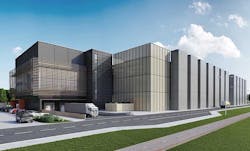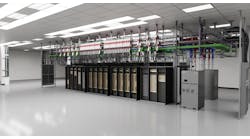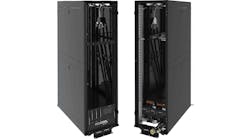Yondr Will Develop Green Energy Projects to Support its Data Centers
Yondr Group will develop renewable energy projects to support its data center campuses, a move that will help its customers reduce their environmental impact.
“We will be launching an energy platform primarily for data center end user clients, and this will be exclusively new renewables that are wholly additional,” said Pete Jones, Chief Development Officer and co-founder of Yondr Group.
Yondr Group plans to build $2 billion of data center projects across the U.S., Canada and Latin America, including 500 megawatts of new capacity in Northern Virginia.
In unveiling plans for an energy platform, Yondr is among the first data center operators to take a direct role in the power generation business. It’s a bold vision that seeks to address the growing role of hyperscale computing in our world, including the need to combat climate change while providing a growing menu of essential services.
It also reflects how large investors are providing resources to expand the capabilities of data center providers. Yondr is an operating company of Cathexis Holdings, a Houston-based investment firm with extensive experience in the energy industry.
Yondr Group’s motto is “tomorrow without constraints,” connecting with its mission to address big challenges facing hyperscale operators.
“We’re always trying to solve for a new dimension,” said Jones. “In North America, we are really trying to position ourselves to solve a different type of problem for our client.”
In many cases, that unsolved dimension involves large-scale developments to address the long-term growth of the largest Internet companies.
“We see that the days of being a two-site, or even five-site data center company are ending,” said Jones. “The conversations with clients are starting to change, and they have portfolio-level issues that we’re trying to solve. They want access to the deepest, broadest portfolio of options that you can possibly give them.”
Vertical Integration on Batteries, Commissioning
Yondr Group was spun out of global construction company ISG in 2019. Both companies are operating units of Cathexis Holdings, a Houston-based investment firm with significant holdings in energy and real estate. Yondr’s leadership team is packed with veterans from Google and Equinix in addition to ISG, and the group has built more than 500 megawatts of data center capacity across Europe since 2011.
Yondr’s relationship with Cathexis provides collaborations that can address foundational challenges in data center development, including sourcing renewable energy. Jones said Yondr’s projects will be “wholly additional,” meaning brand new solar or wind power that would not otherwise have been developed. Some hyperscale operators strongly prefer additionality in renewables, including Google, where Jones previously headed the data center infrastructure team.
The full details of the renewable energy platform will be announced at a later date. Yondr recently hired Ross McConnell as Global Head of Energy to develop and deliver its renewable energy strategy. McConnell comes to Yondr from Naturgy Energy Group Ireland, where he ran a renewable energy business that procured hundreds of megawatts of Power Purchase Agreements (PPAs) for large users.
An Inflection Point on Energy
“We are at an inflection point, with an ever-increasing demand for data center capacity worldwide yet the need to decarbonize energy,” said McConnell. “It’s a fantastic opportunity to deliver impactful energy solutions and help our clients on their renewable and sustainability journeys.”
Jones says the company’s plans are centered on data centers, but not exclusive to them. “Given market dynamics, Yondr isn’t seeking a 1:1 location correlation with our data center portfolio,” said Jones. “We may develop renewables in metros that we do not have data centers and vice versa.”
The early deployments will focus on proven technologies like photovoltaic solar arrays and onshore wind farms, Jones said, adding that Yondr will continue to look at other sustainable options.
“We are investing R&D resources into emerging technologies, but are very wary of both trying to introduce unproven technology into the mission critical sector prematurely, or jumping on trends which do not have enough technical runway beyond a short run macroeconomic trend,” said Jones.
Yondr is also exploring next-generation options for emergency backup power, and addressing labor availability and supply chain disruptions that can slow delivery timelines.
- Energy Storage: Yondr plans to collaborate with BritishVolt, a U.K. based manufacturer of lithium-ion batteries, on energy storage options for data centers. Cathexis led the Series A investment round for BritishVolt, and ISG is leading construction of its huge Gigaplant in Northumberland.
- Vertical Integration: Cathexis has acquired a majority stake in commissioning firms Commtech Asia and UK-based Logi-tek. The vision is to become a global leader in commissioning and technical project management. “These projects are getting harder with all the resource constraints, so we were very intentional about having a sense of vertical integration in the group of companies,” said Jones.
A Focused Development Approach
New data center platforms typically seek to offer capacity in most of the major U.S. markets. Yondr will take a different approach to its expansion in the Americas.
“There is no standing list of markets that we are going after, particularly in the U.S.,” said Jones. “I would expect that in the three-year horizon, we will probably only be in maybe two other metros in the US (besides Virginia). These projects will most likely be at scale, and they will most likely feature a growth story.”
Pete Jones, the CDO and co-founder of data center developer Yondr Group. (Photo: Yondr)
“We are trying to avoid being unhealthy competition in markets that are already really well served by our peers,” Jones said. “We don’t think there’s any glory in being the last people into a crowded market selling the same thing. We’re not going to deliver more capacity into an oversupplied market and make everyone else’s lives harder.”
That raises on obvious question: Why start in Northern Virginia, the largest and most competitive data center market? The region is home to about 250 data centers and more than 10 million square feet of data center space, and houses the largest cloud cluster for Amazon Web Services, as well as major operations for Facebook, Google and Microsoft.
Yondr is among a group of new players entering the Northern Virginia market. One might wonder whether there is room for more new developers, but in recent years Ashburn has seen the debut of four large providers – Cloud HQ, Aligned, Vantage Data Centers and QTS Data Centers – who have seen strong leasing. This suggests there’s enough business to go around, and the extra capacity likely proved important in meeting spikes in demand during the COVID-19 pandemic.
A recent analysis from CBRE found that more than 290 megawatts of capacity are currently under development in Northern Virginia, but the 130 MWs that will deliver in 2021 are all fully pre-leased. The overall vacancy rate stands in the single digits at 8.9 percent, CBRE said, which is a big departure from the occupancy rates in other real estate classes that have been battered by the pandemic.
Large Players Seeking to Consolidate Capacity
Yondr Group has acquired 270 acres of land in Northern Virginia, and plans to build 500 megawatts of data center capacity across Loudoun and Prince William counties, The company acquired the land for its projects from JK Land Holdings, the real estate investment company headed by Chuck Kuhn, the founder and CEO of JK Moving Services. Yondr says it expects to deliver the first phase of its project in early 2023.
Yondr’s interest in Northern Virginia is not a supply-and-demand play. Consistent with its mission, Jones says Yondr’s projects in Northern Virginia are designed to solve a specific problem for hyperscale clients looking to consolidate capacity that’s currently spread across multiple suppliers.
“Cloud clients are working through a portfolio of small colos,” said Jones. “They’ve got 50 megawatts in Metro X, but that’s made up of planning five or more 5-megawatt or 10-megawatt colo (deployments). They want to consolidate. That was an ask from our clients, so that’s the specific case for Northern Virginia – the need to get something much bigger to perform a consolidation exercise.”
In some cases, large customers have worked with multiple providers to spread their risk and encourage competitive bidding for projects. In cloud markets like Northern Virginia, hyperscale customers sometimes have large requirements that must be delivered quickly, and are guided by which provider has capacity available within the required time frame.
Yondr has only shared details for several sites, but plans to develop data center campuses across the Americas, EMEA and APAC. It has publicly announced a strategic partnership with Everstone Group to develop and operate data centers in India. There has also been media coverage of the company’s plans to develop several data centers in Slough in the London market. The Yondr web site suggests the company is considering Houston and Toronto as possible future destinations, along with several sites in South America.
“We’re in it for the long run,” said Jones. “We’re not looking to flip out of assets at a market-beating multiple. We have long-term interests, and the end goal for us is scale.”






